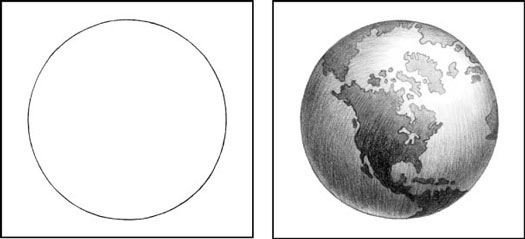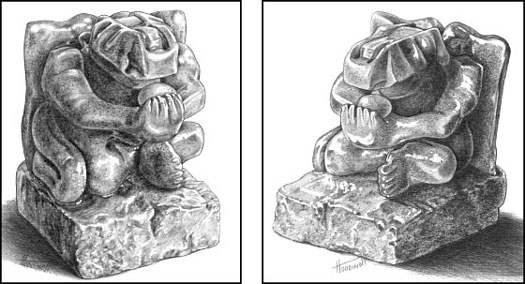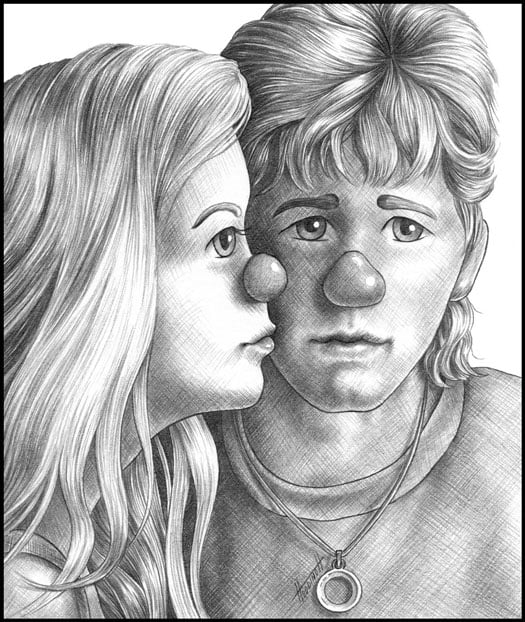Boy Laying Down With a Cast Drawing
Values are the different shades of gray between white and black. Artists use values to translate the light and shadows they see into shading, thus creating the illusion of a third dimension.
Hatching and crosshatching are simple and fun techniques for drawing shading.
A full range of values is the basic ingredient for shading. When you can draw lots of different values, you can begin to add shading, and therefore depth, to your drawings.
With shading, the magical illusion of three-dimensional reality appears on your drawing paper. Figure 1 demonstrates hot to take a simple line drawing of a circle and add shading to transform it into the planet Earth.

You know the objects around you are three-dimensional because you can walk up to them, see them from all sides, and touch them. Take a moment to look around you at familiar objects. Try to discover why you see their actual three-dimensional forms. Look for the different values created by the light and shadows.
Taking a closer look at light and shadow
Before you can draw the appropriate values that illustrate light and shadows correctly, you need to be able to visually identify the following:- Light source: The direction from which a dominant light originates. The placement of this light source affects every aspect of a drawing.
- Shadows: The areas on an object that receive little or no light.
- Cast shadow: The dark area on an adjacent surface where the light is blocked by the solid object.
The light source tells you where to draw all the light values and shadows.
Figure 2 gives you some practice in locating the light source, shadows, and cast shadows around an object, which in this case is a sculpture. As you look at two drawings of the sculpture, ask yourself the following questions:
- Where are the light values? Look for the lightest areas on the object. The very brightest of the lightest values are called highlights.
- Where are the dark values? Dark values often reveal the sections of the object that are in shadow. By locating shadows, you can usually identify the light source.
- Where is the cast shadow? The section of the cast shadow closest to the object is usually the darkest value in a drawing. By locating an object's cast shadow, you can easily discover the direction from which the light source originates.

The two drawings in Figure 2 have different light sources. Compare them and find the dominant light source in each.
If you guessed that the light is coming from the right in the first drawing, you would be correct. In the second drawing, the light originates from the left.
Seeing how a light source affects an actual object is more challenging than examining a drawing. Place an object on a table in a dimly lit room. Shine a powerful flashlight or a lamp (a light source) on the object. Observe it from different perspectives.
Each time you reposition the light source, identify the following:- The shadows on the object (dark values)
- The brightest areas (the highlights)
- The light values (areas closer to the light source or not in shadow)
- The cast shadow (the darkest values)
Exploring contrast in a drawing
Contrast can be used to make your drawings more three-dimensional by accentuating the light and shadows. By using extremes in values (more light and dark values than middle values) you create a high-contrast drawing. For a really powerful, strong, and dynamic drawing, you can draw very dark shading right next to the light areas.When a drawing has mostly light and middle values, it is called low contrast. Some drawing subjects need to be soft and gentle. You can create a very soft drawing and still use a full range of values. Think about a white kitten, for example. Most of the shading is very light, but the drawing becomes more powerful if you use a little dark shading in a few selective areas, such as the pupils of the eyes and the shadows.
Your drawings can appear flat rather than three-dimensional when you use too little contrast in values. Unless you are trying to achieve a specific mood or want the subject to look flat, always use a full range of values.
Figure 3 helps you see contrast while exercising your vision. Take a few moments to explore the light and shadows in this drawing more closely. The face of the girl is drawn in profile. The boy's face is a frontal view. Notice how the girl's profile is in the shadow of the boy's face.The bright light on the front of her face presents a strong contrast to the dark shadow on the side of his face. This makes for a powerful visual separation even though the two faces seem close together.

Translating values you see into values you draw
Almost everything has more than one value. Depending on the light source, most things have some areas that are very light and others that are quite dark.If you look closely at a mound of dark earth, you notice that it has several different values. If a fresh layer of snow covered this mound of earth, there would still be lots of values. When you can see a range of different values you can draw your subject in the third dimension.
Squinting to see values and simple shapes
Seeing values is key to drawing in the third dimension. Many artists can visually simplify complex drawing subjects by simply squinting their eyes. Squinting helps you screen out details and see simple values and shapes. When you can see the shapes created by different values, you can draw your subject more accurately.Look at Figure 4 and squint your eyes until the image seems to go out of focus. Compare the darkest values to the lightest, and try to see the abstract shapes created by the different values.
The second drawing shows what you may see when you squint. Take note of the shapes created by the values.

Turning colors into values with squinting
Many drawing media, such as graphite, are designed for black and white drawings. Yet, almost everything in the world is in color. You need to adjust your visual perceptions to see these colors as shades of gray when drawing.Wouldn't it be nice if you could simply press a button in the middle of your forehead and magically transform the world from full color to gray values? This ability would certainly make drawing a lot easier. Thankfully, simply squinting your eyes can help you develop this skill.
Try these suggestions to help you train your mind to translate colors into values:
- Look around you at different objects. Focus on only the light and dark areas and not the actual colors. Concentrate on the light and shadows. Then squint your eyes until you see the values of that object. Take a mental note of where the lights and darks are. Think about how you could draw these darks and lights. Don't get discouraged if you can't do it right away. With practice, you get better.
- Find a colored photograph with lots of contrast. Squint your eyes to block out the colors and details. In your sketchbook, draw only the simple shapes and values you see. Add shading with only black, white, a light value, and a middle value.
hartmanlarearrive.blogspot.com
Source: https://www.dummies.com/article/academics-the-arts/art-architecture/drawing/general-drawing/drawing-light-and-shadows-200446/
0 Response to "Boy Laying Down With a Cast Drawing"
Post a Comment